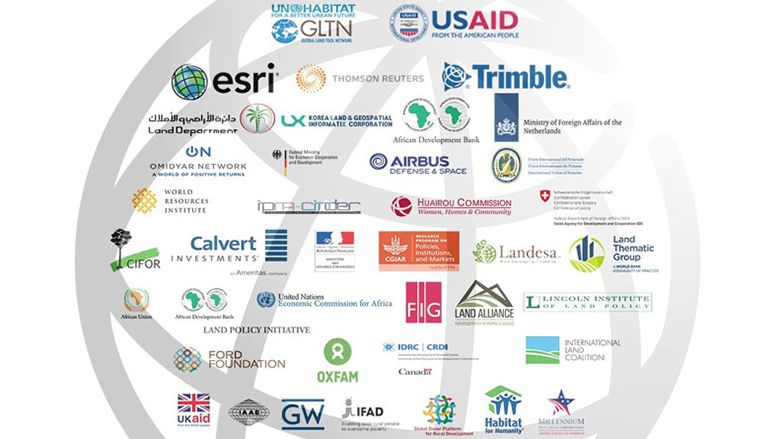| List of Exhibitors for the 2015 Innovations Fair |
| |
 |
|
Through its Geo-Intelligence Portfolio, Airbus Defense and Space is recognized as a World leader in geo-information, pooling an unmatched access to Earth observation satellite imagery with unique expertise and decades of experience in one organization. Based on an exclusive access to Pléiades, SPOT, TerraSAR-X and TanDEM-X (radar and optical satellites), its extensive portfolio spans the entire geo-information value chain. Airbus Defense and Space provides decision-makers with sustainable solutions to increase security, optimize mission planning and operations, boost performance, improve management of natural resources and, last but not least, protect our environment. |
| |
 |
|
BlackBridge is focused on providing end to end solutions across the geospatial value chain. BlackBridge imaging solutions are the only reliable source of high-resolution satellite imagery that provides complete datasets to programs requiring imagery over entire countries or large areas (e.g. REDD+ MRV, Rural Environmental Cadastre (CAR) in Brazil) in short time frames and on a regular basis. The RapidEye Persistent Change Monitoring solution is a new approach to change detection that provides accurate information about where changes occur, reducing the amount of time and resources needed to do cartographic updates or just detect changes. BlackBridge Monitoring Programs present a new approach to access, use and exploit high resolution imagery. |
| |
 |
|
DAI’s are leaders in the development and application of low cost approaches to large scale LTR and completed the entire territory of Rwanda, more than 10 million parcels, in less than five years. This was completed at an average cost of USD $6 per parcel. Their success is not owed to using the latest technology, but to using appropriate technology, adapted to the particular circumstances and ensuring maximum local participation, and extensive outreach and public engagement. Their extensive LTR experience in Sub-Saharan Africa has lead to field-based technologies that are simple, easy for people to comprehend, have acceptable accuracy and are both inexpensive and practical. Having successfully applied this approach in Rwanda, they are now applying an adapted approach in Ethiopia, where DAI will register 14 million parcels in 5 years at an anticipated average cost per parcel of approximately USD $5. |
| |
 |
|
DigitalGlobe is a leading provider of high-resolution earth imagery products and services. Sourced from our advanced satellite constellation, our imagery solutions support diverse customer applications in sustainable global development and land management. DigitalGlobe satellite imagery analysis enables the extraction of valuable information and insight to analyze agricultural areas to promote food security, as well as identifying and quantifying Human Geography trends that can support global poverty mitigation efforts. |
| |
 |
|
Esri inspires and enables people to positively impact the future through a deeper, geographic understanding of the changing world around them. Esri's innovative approach to technology and open data can help improve land governance. Land administration agencies must manage their land information assets efficiently and effectively by moving from legacy "silo" workflows to an enterprise solution. The Esri approach enables this by putting the geodatabase at the heart of a cadastral enterprise transactional workflow. |
| |
 |
|
Geospatial Media and Communications is the only media working in the field of geospatial technologies that uses a number of media channels to create awareness about geospatial technologies with new user groups, connect the stakeholders of this domain and undertake policy advocacy for furthering application of this technology through its print and online publications, conferences and tradeshows as well as commercial research and documentation work. |
| |
 |
|
Managing information about land is a complex, social process involving various social groups -- not just government. Cloudant is the first product to deliver the full functionality of a geospatial information system in a NoSQL, non-relational database. Cloudant's focus on being the easiest to use database for web developers building mobile apps fits well with the information ecosystem of land management. Also, our ability to go offline and have full functionality available is a great fit for areas of the world with limited and/or sporadic internet connectivity. |
| |
 |
|
ITC has 60 years experience in land administration education and training - specifically tailored for developing contexts. STDM was initially developed at ITC. Our student cohorts are diverse. ITC offers distance programs and short courses. Research is infused in our educational packages. Training and capacity building are a core part of our mission. |
| |
 |
|
LAND INFO Worldwide Mapping, LLC remote sensing solutions combine the global reach of satellite imagery with advanced processing methods and software technologies to improve mapping results in challenging project locations. Map data sets such as ortho mosaics, land-use/cover, urban sprawl change detection, building foot-prints and 3D urban building models can be created faster and less expensive vs. traditional methods. New technologies such as Object Based Image Analysis improve the mapping results of data sets often needed to support World Bank projects, such as building foot-prints, land-use and urban sprawl change detection. These new technologies also offer significant cost-savings and turn-around time improvements over traditional methods. LAND INFO will show global examples including Tanzania, Afghanistan, India and other locations. |
| |
 |
|
By bringing land information together in one place, the Land Portal is able to actively address gaps in information, while providing a range of ways for the information to be accessed, shared and reused. This will increase the effective use of information and ultimately will lead to better decision making on land governance. The new Land Portal is a pioneering hub for ‘linked open data’ on land - non-proprietary data that uses semantic tools to share and connect data, information and knowledge. This enables the Land Portal to publish structured data in machine readable, standardised formats under open licenses that can be reused by anyone. |
| |
 |
|
Highly automated and affordable, Micro Aerial Projects products and services provide an opportunity to build local small enterprise capacities in aerial image acquisition and geo-spatial data production, thus improving citizen engagement in the production of fit for purpose geo-spatial data. Our unmanned aerial systems and related processing software provides empowering tools for small enterprises in the fields of aerial image acquisitions, mapping, 3D modeling and visualizations with virtual surveying tools. |
| |
 |
|
GeoQ is hosted on the National Geospatial-Intelligence Agency’s GitHub repository, a ground-breaking initiative to share tools and techniques with the Geographic Information Systems community as well as other organizations around the world. By distributing this system as an open source project, NGA has provided a low cost tool for organizing and managing relief activities during a time of crisis. The benefits of managing all aspects of a crisis event, such as rescue teams, law-enforcement personnel and utility crews provide immediate impact to the affected areas, allowing for relief activities to proceed much sooner and communities to quickly return to normal. |
| |
 |
|
Pitney Bowes' suite of geospatial analysis software and data provide a more product framework for users that want to explore land and asset management. Our global portfolio of data products provides the foundation on which specific land information can be analyzed. Pitney Bowes' provides the most accurate geocoding solutions for over 120 countries at the parcel level and 240 countries as the postal code level. Geographic information system technology is providing the location intelligence that helps develop effect land administration and property management policy. The ability to quickly retrieve and integrate digital land records, land use patterns, new earth observation satellite imagery and relevant demographic data can help policy makers develop effective decisions for poverty mitigation and land use planning for long-range economic development. |
| |
 |
|
Terra Pixel provides a browser based Platform as a Service (PaaS) that provides access to geospatial data through Open Geospatial Standards compliant API’s and existing Internet browsers. Our software processes data on the infrastructure level (where the data resides) allowing users to federate information across infrastructures and into applications. Terra Pixel will showcase the power of processing interoperability capabilities. |
| |
 |
|
Thomson Reuters offers a comprehensive suite of products supporting land administration such as registry, cadastre and valuation, and boasts a decade-plus legacy of delivering innovative solutions that have helped developing countries address development goals and alleviate poverty. With deployments in 50 countries managing 65 million parcels and 10 million documents each year, Thomson Reuters global land and property solutions enable governments with the tools needed for development and help them collect more than $100 billion in revenue annually. |
| |
| |
|
Achieving food security for all is at the heart of FAO's efforts – to make sure people have regular access to enough high-quality food to lead active, healthy lives.FAO’s latest product is Open Tenure, software using mobile devices for the crowd sourced recording of tenure rights by citizens and communities. Coupled with Open Tenure is the web based Community Server where Open Tenure recorded tenure rights are displayed, subjected to community moderation and then endorsed as recognized by the community. The SOLA family of software from FAO provides affordable, customizable, scalable, LADM compliant, “open data” ready solutions incorporating international good practice that provide the means to enhance tenure security. This software has been especially designed to implement much of the Voluntary Guidelines for Responsible Governance of Tenure (VGGT). |
| |
 |
|
USAID has developed two innovative products that use mobile technology. The Mobile Application to Strengthen Tenure (MAST) product uses an open source platform to gather land rights information in a participatory manner. This flexible, accessible approach will enable Tanzanian villagers to acquire land use certificates (CCROs) in a timely, less costly manner. The Land Potential Knowledge System (LandPKS) also uses a low-cost, open source platform to increase knowledge of land’s potential which will improve land use decision making and management and connect farmers, pastoralists and other producers with critically important, but hard-to-access local knowledge and scientific information about soil quality and conditions. |
| |
 |
|
The Web3D Consortium is an international, non-profit, member funded, industry standards development organization. Web3D Consortium members create and promote open standards for real-time 3D communication. Today, the Web3D Consortium is utilizing its broad-based industry support to develop the ISO Standard Extensible 3D (X3D) which was designed to live on the web and play well with other standards technologies in the web stack; it is innovative in that it brings interactive 3D data to the web browser, thus enabling real-time data fusion and analysis environments, for example the 3D portrayal of geo-referenced sensor and simulation data. |
| |
|
|
 |
|
There are at least 135 countries that are unaddressed. what3words tackles the issue of poorly or unaddressed countries by providing an alternative way to communicate location using only words and available in many different languages. |












